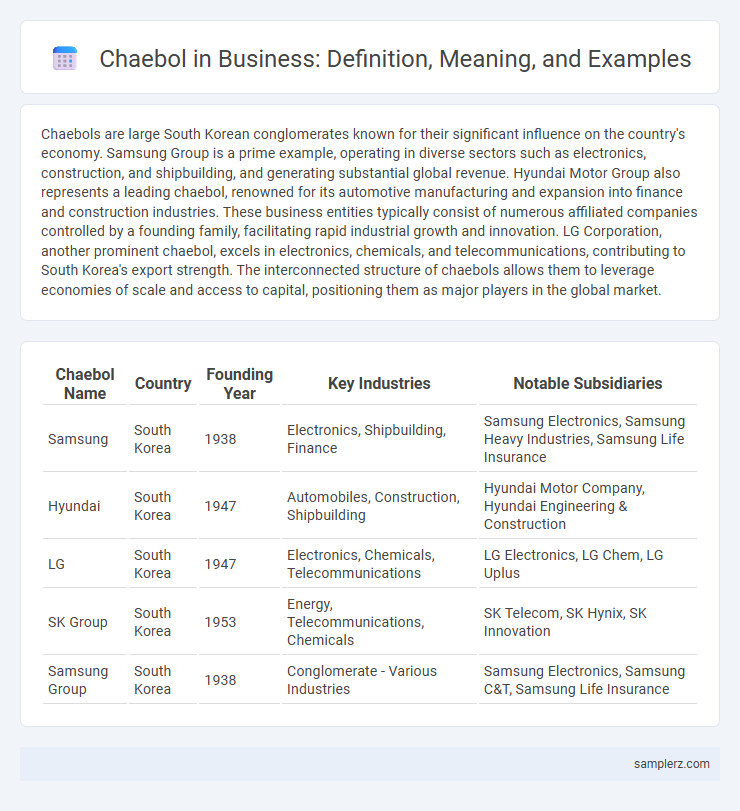Chaebols are large South Korean conglomerates known for their significant influence on the country's economy. Samsung Group is a prime example, operating in diverse sectors such as electronics, construction, and shipbuilding, and generating substantial global revenue. Hyundai Motor Group also represents a leading chaebol, renowned for its automotive manufacturing and expansion into finance and construction industries. These business entities typically consist of numerous affiliated companies controlled by a founding family, facilitating rapid industrial growth and innovation. LG Corporation, another prominent chaebol, excels in electronics, chemicals, and telecommunications, contributing to South Korea's export strength. The interconnected structure of chaebols allows them to leverage economies of scale and access to capital, positioning them as major players in the global market.
Table of Comparison
| Chaebol Name | Country | Founding Year | Key Industries | Notable Subsidiaries |
|---|---|---|---|---|
| Samsung | South Korea | 1938 | Electronics, Shipbuilding, Finance | Samsung Electronics, Samsung Heavy Industries, Samsung Life Insurance |
| Hyundai | South Korea | 1947 | Automobiles, Construction, Shipbuilding | Hyundai Motor Company, Hyundai Engineering & Construction |
| LG | South Korea | 1947 | Electronics, Chemicals, Telecommunications | LG Electronics, LG Chem, LG Uplus |
| SK Group | South Korea | 1953 | Energy, Telecommunications, Chemicals | SK Telecom, SK Hynix, SK Innovation |
| Samsung Group | South Korea | 1938 | Conglomerate - Various Industries | Samsung Electronics, Samsung C&T, Samsung Life Insurance |
Understanding the Chaebol Structure in Business
Samsung Group exemplifies the chaebol structure in business, consisting of numerous interlinked subsidiaries controlled by a central family, enabling diversified operations across industries such as electronics, construction, and finance. This complex hierarchical ownership allows Samsung to leverage cross-company resources and maintain centralized strategic decision-making, often leading to significant market influence and resilience. The chaebol structure's reliance on family control intertwined with corporate governance creates unique challenges in transparency and regulatory compliance.
Historical Emergence of Chaebols in South Korea
The historical emergence of chaebols in South Korea traces back to the post-Korean War era when the government prioritized rapid industrialization through close cooperation with family-owned conglomerates. Samsung, Hyundai, and LG are prime examples of chaebols that expanded from small trading companies into global industrial giants by leveraging state-led economic policies and favorable financing. These chaebols played a critical role in transforming South Korea into a major economic power during the late 20th century.
Samsung Group: The Quintessential Chaebol Example
Samsung Group, a dominant South Korean chaebol, exemplifies the conglomerate business model with diverse subsidiaries spanning electronics, construction, and finance. Its flagship company, Samsung Electronics, leads the global market in semiconductor manufacturing and consumer technology products, contributing significantly to South Korea's GDP. The group's integrated structure enables efficient resource allocation and innovation, reinforcing its position as a powerhouse in international business.
Hyundai Motor Group: Diversification and Expansion
Hyundai Motor Group exemplifies chaebol success through strategic diversification and global expansion, operating across automobile manufacturing, construction, and finance sectors. The group's extensive portfolio includes Hyundai Motors, Kia, and Hyundai Steel, enabling synergies and competitive advantages in the global market. Aggressive investment in electric vehicles and smart mobility technologies further strengthens Hyundai's position as a leading conglomerate in the automotive industry.
LG Corporation: Innovations in Electronics and Beyond
LG Corporation exemplifies a leading chaebol renowned for pioneering innovations in electronics, including cutting-edge advancements in OLED display technology, home appliances, and mobile communications. The conglomerate's diversified portfolio extends beyond electronics into chemicals, telecommunications, and entertainment, driving sustained growth and global market presence. LG's strategic investments in research and development fuel continuous innovation, positioning it as a dominant player in the competitive global business landscape.
SK Group: From Energy to Telecommunications
SK Group exemplifies a leading South Korean chaebol, with diversified business ventures spanning energy, telecommunications, and chemicals. The conglomerate's energy sector includes SK Innovation, a major player in oil refining and battery production for electric vehicles. In telecommunications, SK Telecom stands as South Korea's largest wireless carrier, driving innovations in 5G technology and digital services.
Lotte Group: Retail and Hospitality Powerhouse
Lotte Group stands as a prime example of a chaebol, dominating South Korea's retail and hospitality sectors with a diverse portfolio that includes Lotte Department Store and Lotte Hotels & Resorts. Its vast network extends internationally, leveraging integrated business strategies to drive revenue growth and market expansion. The conglomerate's influence is marked by innovation in customer experience and strategic investments in both domestic and global markets.
CJ Group: Influence in Food and Entertainment
CJ Group exemplifies a powerful South Korean chaebol with significant influence in both food and entertainment industries. Its diversified operations span global food production, biotechnology, film, and music, contributing to its leadership in the competitive market. The group's strategic investments in content creation and distribution have expanded its cultural impact, reinforcing its status as a key player in the global entertainment sector.
Hanwha Group: Growth in Chemicals and Finance
Hanwha Group exemplifies chaebol success with its significant growth in chemicals and finance sectors, securing a leading position in South Korea's industrial landscape. The conglomerate's expansion in petrochemicals and advanced materials has driven robust revenue increases, while its finance arm offers comprehensive services including insurance, asset management, and banking. Strategic investments and innovation enable Hanwha to sustain competitive advantages and support South Korea's economic development.
The Global Impact and Future of Chaebols
Samsung, Hyundai, and LG exemplify chaebols that have significantly influenced global markets through innovation and massive export networks. These conglomerates drive South Korea's economy by adapting to the digital age with investments in AI, renewable energy, and electric vehicles. Their future success depends on enhancing corporate transparency and governance to sustain international competitiveness and economic growth.

example of chaebol in business Infographic
 samplerz.com
samplerz.com